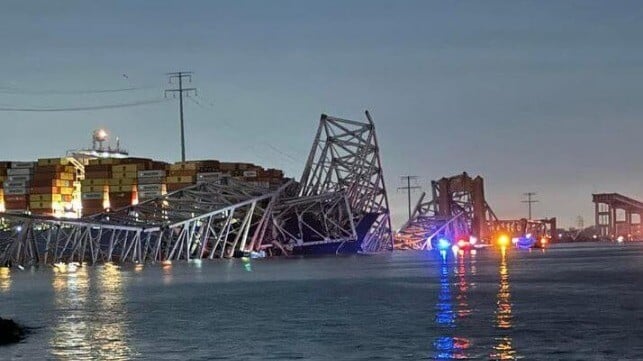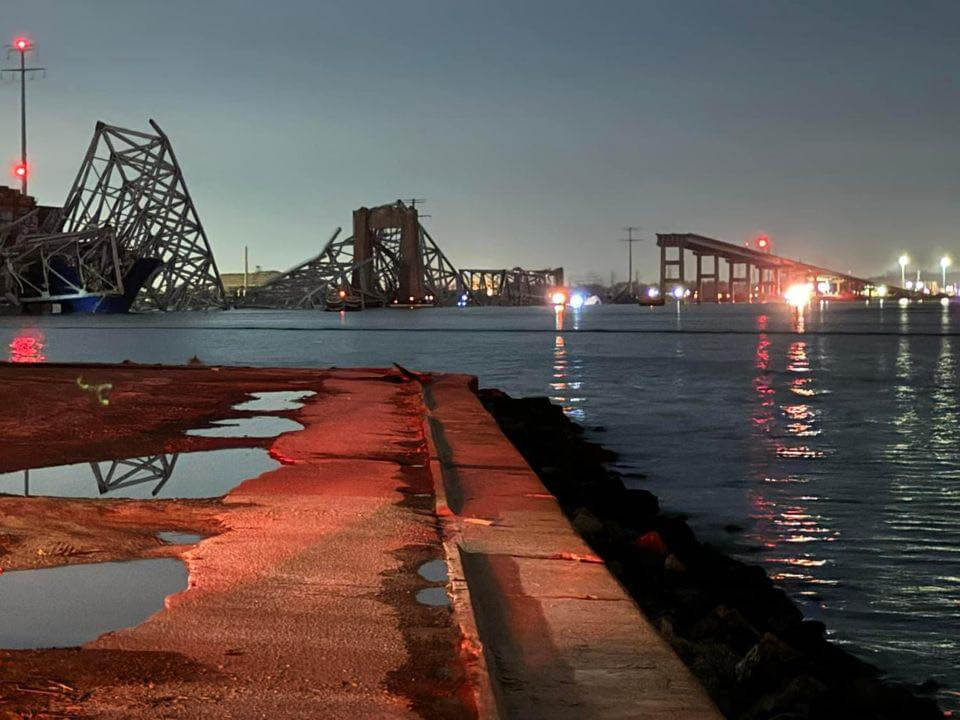Containership Hits Baltimore Bridge, Causing Collapse

In the early hours of Tuesday morning, a containership outbound from the Port of Baltimore collided with one of the pillars of one of the city’s primary roadway bridges, causing the bridge to collapse. City, state, and federal authorities are calling it a possible mass casualty event.
In a morning briefing, the Baltimore Fire Department reported that two people were found in the water and one was taken to a local hospital in critical condition. A road crew was working on the bridge deck, and six people from the crew are missing and presumed dead.
Rescue operations were hampered by cold water and a strong current. Reports are that the water is at 47 degrees Fahrenheit (8 degrees Celsius). Teams from the local emergency responders as well as U.S. Coast Guard vessels and helicopters are on scene. Divers reported dangerous conditions in the water, including low visibility, frigid temperatures and tangled debris from the downed bridge.
The U.S. Coast Guard called off the search on Tuesday night, saying that too much time had elapsed to hope for rescuing any further survivors. "Based on the length of time that we've gone in the search, the extensive search efforts that we put into it, the water temperature . . . we do not believe that we're going to find any of these individuals still alive," Rear Adm. Shannon Gilreath said at a press conference.
Maryland Governor Wes Moore reported that the containership radioed that it had lost power and was in danger of hitting the bridge. The Governor said the warning had permitted them to limit traffic on the bridge. He also emphasized that there are no indications of anything but a mechanical failure although there will be further investigations.
The vessel, the 984-foot-long Dali (116,581 dwt) owned by Grace Ocean and managed by Synergy Marine, departed the Baltimore container terminal shortly after midnight local time and had two pilots aboard as it was navigating the harbor exit. Reports are the vessel was moving at up to 9 knots. A large amount of smoke can be seen coming from the funnel as the vessel neared the bridge at approximately 1:30 AM local time, and it was to one side out of the main channel. The onboard lights appear to flicker several times as well. Videos show the massive bridge collapsing onto the ship and into the water.
The Associated Press is quoting the pilots' association reporting that after the vessel lost power the pilot attempted to drop anchor and steered the ship in an effort to reduce the dangers. They also contacted the dispatch office to get the bridge closed. The pilot was attempting to slow the vessel but never regained propulsion.
The Volunteer Firefighters from @jmvfc8, the Volunteer Swift Water Team and the @HarfordCoDES Special Operations Team are assisting the Unified Command at the Baltimore Francis Scott Key Bridge collapse. pic.twitter.com/ipoTR2HljY
— Harford Co., MD Fire & EMS (@HarforCoFireEMS) March 26, 2024
The containership has a capacity of 10,000 TEU. Synergy reports the vessel had 4,679 TEU loaded and that the 22 crew, all Indian nationals, have been accounted for and are uninjured.
The Baltimore Fire Department said there is cargo hanging from the remaining structure of the bridge, possibly from the Dali. The situation remains critical with the remaining sections of the bridge considered dangerous and unstable. The bridge was built in 1977 crossing the Patapsco River near the entrance to the harbor.
Built in 2015, the vessel is registered in Singapore. It is currently operating under charter to Maersk and was outbound for Colombo, Sri Lanka. Maersk issued a statement reporting it was closely following developments saying the company was "horrified." It said that no Maersk personnel were aboard the vessel.
Baltimore is the ninth-largest port in the U.S. and one of the major East Coast destinations for containers and autos. In 2023, Baltimore handled more than 52 million tons of cargo including one million TEU. According to an analysis by Bloomberg, Baltimore handles only about three percent of the East Coast container traffic, but it handlles the nation’s largest volume of automobiles, as well as bulk cargoes such as coal, gypsum and lumber.
Traffic into and out of the port is suspended at this time. MarineTraffic calculates that there are at least eight bulkers and a car carrier outside the harbor at anchor and several vessels appear stuck inside the port. However, no containerships were reported at the terminals. Both Maersk and MSC announced that they would immediately begin rerouting traffic while both companies have customers' shipments aboard the Dali. MSC wrote to customers on the recovery in Baltimore, "We expect this to take several months and all MSC customer cargo will be rerouted and discharged at alternative ports in the meantime."
“The immediate focus is the rescue operation, but there will clearly be a highly-complex recovery phase and investigation to follow," said Emily Stausbøll, Market Analyst at Xeneta. "The question is how quickly ocean freight carriers can put diversions in place, particularly for vessels already en route to Baltimore or containers at the port waiting to be exported."
Bill Doyle, CEO and Executive Director of The Dredging Contractors of America (DCA), tells The Maritime Executive that Manson Construction, Dutra Group, Kokosing Contractors, and Sterling Marine are nearby onsite awaiting orders. He said there are other U.S. flag operators with tugs, barges, and other marine emergency equipment that authorities can get to assist. He also mentioned that marine traffic in the area will be stopped until further orders by the U.S. Coast Guard. Doyle recently served nearly three years as the Executive Director of the Port of Baltimore.


that matters most
Get the latest maritime news delivered to your inbox daily.
